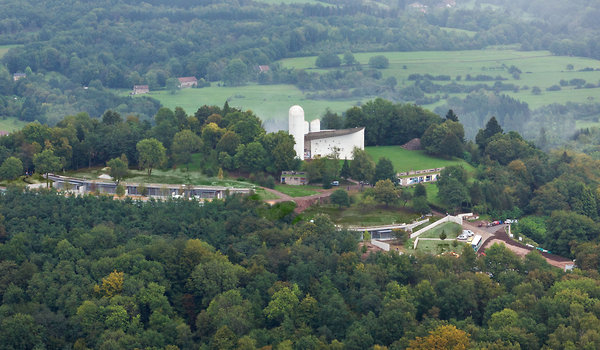Se ne occupa il New York Times: Renzo Piano, in silenzio, ha aggiunto una sua opera a quella forse più famosa di Le Corbusier, Notre Dame du Hsut. Meier, Pelli, Moneo e altre archistar inorridiscono e lanciano appelli. Dal NYT del 17.4.12:
Architecture Review
Quietly Adding to a Modernist Masterpiece
A new convent and new visitors’ center, designed by Renzo Piano, has been added to the site of Le Corbusier’s hilltop chapel of Notre Dame du Haut.
By MICHAEL KIMMELMAN
Published: April 17, 2012
RONCHAMP, France — Completed in 1955, Le Corbusier’s hilltop chapel of Notre Dame du Haut in this hardscrabble patch of eastern France attracts some 100,000 supplicants each year, architectural and religious. If critics still sometimes blame Le Corbusier for inspiring generations of soulless, cookie-cutter housing projects and office parks, he remains the high priest of Modernism for singular works like this.
So it was predictable that a firestorm broke several years ago after plans circulated for a convent and new visitors’ center at the site of the chapel. Renzo Piano was the designer. Big-name colleagues like Richard Meier, Rafael Moneo and Cesar Pelli signed an online petition denouncing the $16 million project. The Fondation Le Corbusier, keeper of the architect’s flame, fumed.
Now the buildings have opened, with some landscaping (by Atelier Corajoud, a Paris firm) and a bit of last-minute tinkering yet to come. I took a train from Paris recently and found the chapel empty on a bright, crisp spring morning (a godsend), then visited the nuns. They are not quite a dozen elderly Poor Clares, lately moved from their home of 800 years at Besançon, 60 miles to the south, which they had sold to help pay for the new place. Cheerful in their light gray habits, the sisters were finishing lunch in the refectory around a handsome glazed courtyard open to a cloudless sky.
A few minor acoustic problems with the nuns’ concrete quarters aside, Mr. Piano and his team (Paul Vincent was the partner in charge at Renzo Piano Building Workshop) have created remarkably light and peaceful spaces that are virtually invisible from the chapel and gracefully connected to nature. Competing with Le Corbusier’s masterwork would have been a fool’s game and an affront, Mr. Piano clearly realized; spoiling it, a cinch. Doing neither, the additions insert new life onto the hill, and in the process remove a despised 1960s gatehouse that had obscured sight of the chapel from the town below.
Humility is a virtue. That’s the obvious lesson, but doing anything, even constructing a few self-effacing buildings at Ronchamp, is a big deal. Mr. Piano solved the riddle of adding to a site without appearing conspicuously to do so by burrowing into the brow of the hill, below the chapel, and inserting the convent and visitors’ center into the cuts, half buried, with zinc-and-glass facades to let in light. He placed the visitors’ center beside the old pilgrims’ path, which winds through woods from the valley all the way up the hill, and adjacent to a parking lot, which has been usefully trimmed.
A fire was crackling in the fireplace at the center when I stopped by to browse through the bookshop. A ramp led from there onto the dirt path rising to the chapel. Behind the opposite end of the visitors’ center, set apart by a tiny gate, the convent wrapped several hundred feet farther around the slope.
It looked like a miniature hill town. Two stories of concrete cells, the nuns’ quarters and workrooms, fronted by winter gardens and linked on the inside by somber corridors and stairs, opened to trees and sweeping views. Simple corrugated zinc roofs on slender steel pillars shaded the cells, which fanned outward like the leaves of folding screens. The materials — concrete, zinc and wood — created an atmosphere chaste and calm, the smell of cedar scenting the halls, the oratory — a trapezoidal room topped by a gently vaulted roof like the keel of a boat — sparingly decorated with an olivewood altar and bright orange floor.
Of course imposing anything on this hill, even half-buried buildings, impinges on what Le Corbusier saw in the 1950s as the “poem” of the larger site, with its interplay of forest and chapel, the chapel’s curves gesturing explicitly toward the Jura and Vosges Mountains, as if to embrace them in the poem’s narrative.
The site had held one chapel after another since the fourth century, so it has changed often. Devotees of Le Corbusier have come increasingly to perceive it as an untouchable shrine to him. A characteristically French subtext of anti-clericalism partly fueled the contretemps, which came down to architectural preservation versus prayer, an inviolable site versus a living one.
The Poor Clares, with the Association de l’Oeuvre Notre Dame du Haut (not incidentally, the organization that first hired Le Corbusier more than half a century ago), commissioned Mr. Piano. The aim was to devise a convent “beside the chapel that could thrive among pilgrims and tourists, and breathe life back onto the hill,” as Brigitte de Singly, the convent’s abbess, put it.


